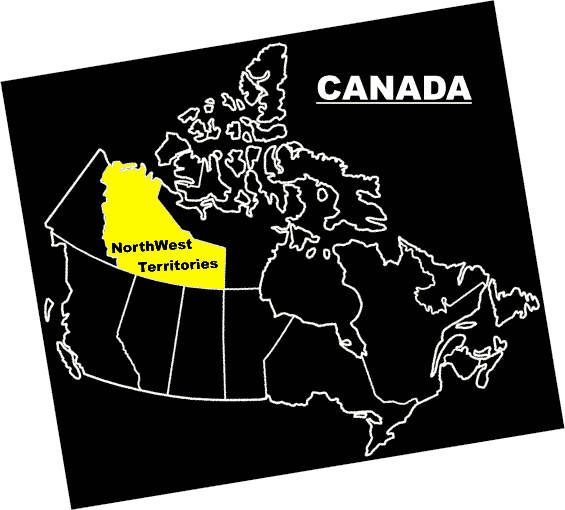Time in Northwest Territories (Canada)
What is the Time in Northwest Territories (Canada)
The analog clock above is displaying the current local time in Northwest
Territories of Canada. The analog clock displays Mountain Daylight Saving Time
whenever DST is in force in Northwest Territories of Canada. The DST comes into force
some time in March and remains till November. The real Zone Time in
Northwest Territories is UTC-7:00 hours Mountain Time. However, with the onset of DST in
March, the clock is advanced by one hour to read UTC-6:00 hour Mountain Daylight
Time. In November,
this extra one day light hour given to the public gets withdrawn and the
clocks will be reset back to UTC-7:00 hours Mountain Time. This gets repeated yearly.
 Land
Water Areas at this time in Northwest Territories
Land
Water Areas at this time in Northwest Territories
At this time Northwest Territories is ranked third in Canada. The total area
covered stands at 1,345,106 square kilometers. The total water covered area in
Northwest Territories is about 163,021 square kilometers which is about 12.1% of
the total area of Northwest Territories. The total area of Northwest Territories
is about 13.5% of the total land area of Canada.
Population at this Time in Northwest Territories
At this time the population in Northwest Territories is about 44,000 or more. In
2011 the population was estimated at 41,462 during the census which was the same
as five years back in 2006 also. In 2001 the census proved the population in the
Northwest Territories as 37,360. In the year 1951 that is 50 years back it was
just 16,004 or half of that in 2001. But if you see another 50 years back, that
is 1901, the population was more by 4000 and stood at 20,129. Amazingly, the
population was 98,967 which is the highest in the history in 1891. Where did
that population vanish in just 10 years? In 1881 just 10 more years back the
population was just 56,446.
Northwest Territories Capital
The Capital of Northwest Territories at this time is Yellowknife. The largest
city in Northwest Territories is also Yellowknife which is incidentally also the
largest Metro. Yellowknife became teritorial capital in 1967.
Languages at this time in Northwest Territories
At this time in Northwest Territories there are atleast 11 Official languages
namely English spoken by 77.% people followed by 4.8% speaking Dogrib, 3.2%
people speaking South Slavey. Then there are less than 1000 people each speaking
Inuktitut, Tagalog, Chipewyan, Vietnamese, Chinese, Gwich'in, Inuinnaqtun and
Cree at this time in Northwest Territories.
Climate at this time in Northwest Territories
At this time in Northwest Territories owing to its large land area of 1.3
million square kilometers there is a large climate variations. Subarctic climate
prevails in most of southern part of the Northwest Territories where as the
islands and the northern coast experience a polar climate. Summers happen to be
short and cool in the north with average daytime temperatures at 65 deg F and
the lowest temperatures stands at about 50 deg F. Winters therefore are long and
harsh with daytime temperatures standing at -20 deg C or -4 deg F and lowest at
-40 deg C or -40 deg F often dipping to -50 deg C. Ocassional thunderstorms
happen at times in the south and none in northern parts.
Tourism at this time in Northwest Territories
At this time in Northwest Territories tourism is catching up fairly well with
the Great Bear Lake which is the largest lake entirely within Canada, The Great
Slave Lake which is the deepest water body in North America of 2014 feet depth,
then the Mackenzie River, the canyons of the Nahanni National Park Reserve,
UNESCO World Heritage Site and much more to view and experience for the tourists
in Northwest Territories of Canada.
Government at this time in Northwest Territories
At this time in Northwest Territories the government is Conces type called the
Legislative Assembly which has much less rights than the provinces. The
Commissioner of the Northwest Territories is the Chief Executive who is apponted
by the Governor-in-Council of Canada on the recommendations of the Federal
Minister of Aboriginals Affairs and Norther Development. The Commissioner had
full governing powers till 1980 when the territories were given greater
self-government and then the Legislative Assembly started to elect a Cainet and
Government Leader who is at this time called the Premier. Starting with the year
1985 the meetings of the Executive Council now called the Cabinet is not chaired
by the Commissioner anymore. The Commissioner now is something similiar to the
Lieutenant Governor in other Provinces with the only difference that the
Commissioner of the Northwest Territories is not a formal representative of the
Queen of Canada.
The difference between the provincial governments and the
Territories government is that the Northwest Territories does not have political
parties except between 1898 to 1905. At this time the Northwest Territories has
a Conces government with a Legislative Assembly composed of one member elected
from each of the nineteen constituencies of Northwest Territories. Once the
general elections are over, the new assembly will elect its Premier and the
Speaker using Secret Ballot. Seven MLA or Member of Legislative Assembly are
also elected as cabinet ministers and the reminder will become the opposition.
The 18th Legislative Assembly was the result of elections held on 23 November
2015. There is a single Senate division and Single House of Commons electoral
district titled Northwest Territories in the Parliament of Canada.
Why Named Northwest Territories?
The name north western territory was adopted by the British government at that
time. When Nunavut split, there was an effort to change the name. One of the
proposed names was Denendeh in Athabaskan language which means Our Land.
However, the name Northwest Territories remained as it looked more logical
because these territories actually extened into Canada's north western and north
central areas.